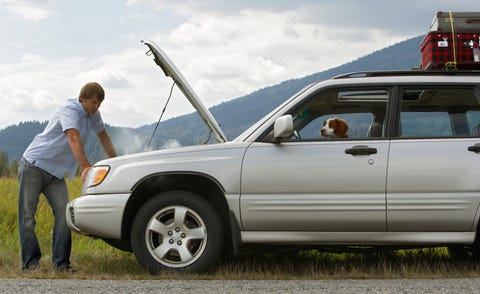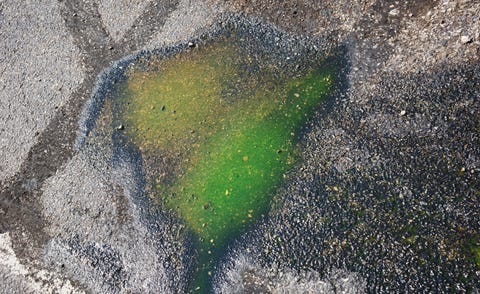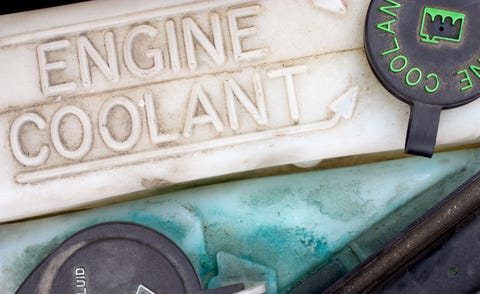how to find a coolant leak
If you've noticed an odd, sweet smell coming from your car after you shut the engine off you might have an antifreeze leak. Antifreeze plays a key part in keeping your engine running properly, so it's important to know if it's leaking.
If your vehicle is leaking antifreeze, the problem needs to be repaired promptly, before it causes much bigger, more costly issues.
Despite its name, antifreeze does more than just keep your vehicle's radiator from freezing up in winter. It's part of your vehicle's cooling system, which controls the engine's temperature so that it runs properly and doesn't overheat.
Your engine's radiator is actually filled with what's called coolant, a 50-50 mix of antifreeze and water. A pump on the engine circulates the coolant through the radiator, engine, and heater and keeps your engine running at the proper temperature—and not overheating—regardless of the outside temperature. If an engine is low on coolant, it can run too hot, which will hurt both performance and fuel economy. Worse yet, your engine can overheat, sustaining expensive and possibly terminal damage.

Getty Images
If your vehicle is losing coolant, you need to determine where it's leaking from and how fast it's leaking—and then fix it or get it fixed. The engine's cooling system is complex and has many parts. A coolant leak could be as cheap and simple to repair as tightening a loose clamp on one of the system's several hoses—something you can do yourself. Or it can be as complicated and expensive to repair as replacing a broken water pump. A major problem like that will require the skills of a technician to diagnose it and a shop full of tools to repair it.
Clues You Have an Antifreeze Leak

Getty Images
- A sweet aroma that you notice from outside the vehicle, coming from the vehicle after you've driven it. You might be able to smell it from behind the wheel as well.
- Puddles under the car of lime-green, orange, pink, or blue-green after you've parked. Antifreeze makers use those dye colors to differentiate coolant from other fluids used in cars. Engine oil is gold or black (when dirty), and transmission fluid is dark red.
- The car starts running hot or overheating.
How to Locate a Leak
- To find a leak, first drive the car until it's fully warmed up, then park it on a clean, dry section of pavement—a driveway if possible.
- Shut it off and let it cool down. Caution: When the vehicle is fully warmed up, the coolant is boiling hot and under pressure. Do not remove the recovery-tank cap or radiator cap before the engine has adequately cooled. They are located under the hood. The illustration below shows the location of the caps for the radiator and the translucent plastic recovery tank. Most recovery tank caps are marked with a symbol similar to the one shown. Some cars do not have a radiator cap.

Jeff Xu Car and Driver
- After the car sits for 15 minutes, look under it for a fresh puddle of antifreeze-colored fluid. If there is no puddle but you smell the sweet aroma of antifreeze, kneel down and scan the vehicle's underside and see if you can see anything that's wet or covered in droplets. Note: air conditioning systems often form condensation that can leak on to the ground, but what's dripping from them is pure, clear water.
- If a small puddle or stain of coolant forms under the car near the front of the vehicle lift the hood and start looking in the engine bay. It's also a good time to literally sniff around to see if you can tell where the antifreeze smell might be coming from.
- Look for signs of coolant leakage—a light-colored residue or stain—around the radiator cap, on hoses throughout the engine compartment (check the ends where they are clamped to other components) and on the radiator itself. If it looks like a hose is leaking near a clamp, try tightening the clamp with a screwdriver. If you don't see any obvious signs of leakage, scan the entire engine compartment; the leak could be coming from somewhere else under the hood.
- If the smell is stronger inside your vehicle than outside of it, the problem could be inside the heater. Heaters utilize a small radiator-like "core" to heat the cabin air. If the carpet is damp or the windows seem to fog up easily, the heater core could be leaking. Heater-core leaks are hard to locate and even harder to fix because the heater is part of the air conditioning system, which is buried behind the instrument panel. If that's the case, unless you're great with wrenches see a technician.
If You Can't Locate the Leak
Not finding the leak doesn't mean you don't have one. After the engine fully cools down, check your vehicle's coolant level by observing how much fluid is in your vehicle's coolant-recovery tank. The coolant-level indicator is on the side of the translucent plastic tank. Most tanks have clear minimum and maximum markings. The coolant level should be between the "min" and "max" markings. If the tank is full, what you are smelling is probably not an antifreeze leak. If the tank's level is below the minimum mark or it's dry, you've likely got a problem and it is time to consult an expert technician. They can use a cooling-system pressure tester to home in on the source of the leak.

Getty Images
Driving With an Antifreeze Leak
How long can you drive with an antifreeze leak? We recommend getting it fixed as soon as possible. Cooling system problems don't get better by themselves and can deteriorate fast. You don't want to be stranded by the side of the road because you ignored the early signs of an antifreeze leak.
If you're the kind that pushes their luck and you have a a minor (slow) coolant leak and it's summer, you can likely drive for a few days by topping off the cooling system with water whenever it gets low. It's always best, however, to refill a cooling system with the proper mix of antifreeze and water in a 50-50 ratio, especially in winter. Plain water sitting in an engine on a freezing winter night turns to ice and expands. That expansion could easily burst the radiator, split cooling system hoses, and even crack the engine block or a cylinder head—which would destroy your engine. Antifreeze lowers the freezing point of the coolant to somewhere around minus 35 degrees F to keep any damage from happening. Again, it's far better to get your car looked at as soon as possible to prevent more serious and expensive engine damage.
Lastly, different cars require different types of antifreeze. There are three main types of antifreeze: older-style ethylene glycol (green dye); propylene glycol (orange or yellow dye); and the newest hybrid organic acid technology (yellow, green, pink, blue, violet, or orange). The different types can't be mixed. Refer to your owner's manual or consult the dealer for the correct replacement type.
Important: Ethylene glycol antifreeze is highly toxic if ingested. Because of its sweet smell and inoffensive taste, it is a serious hazard for children and pets.
This content is imported from {embed-name}. You may be able to find the same content in another format, or you may be able to find more information, at their web site.
This content is created and maintained by a third party, and imported onto this page to help users provide their email addresses. You may be able to find more information about this and similar content at piano.io
how to find a coolant leak
Source: https://www.caranddriver.com/features/a27543190/antifreeze-leak/#:~:text=Look%20for%20signs%20of%20coolant,the%20clamp%20with%20a%20screwdriver.
Posted by: mcquadefrouss.blogspot.com

0 Response to "how to find a coolant leak"
Post a Comment